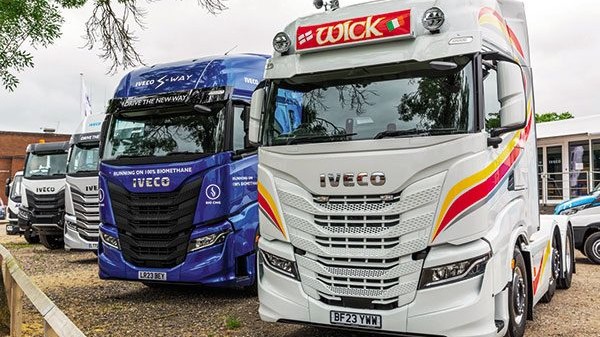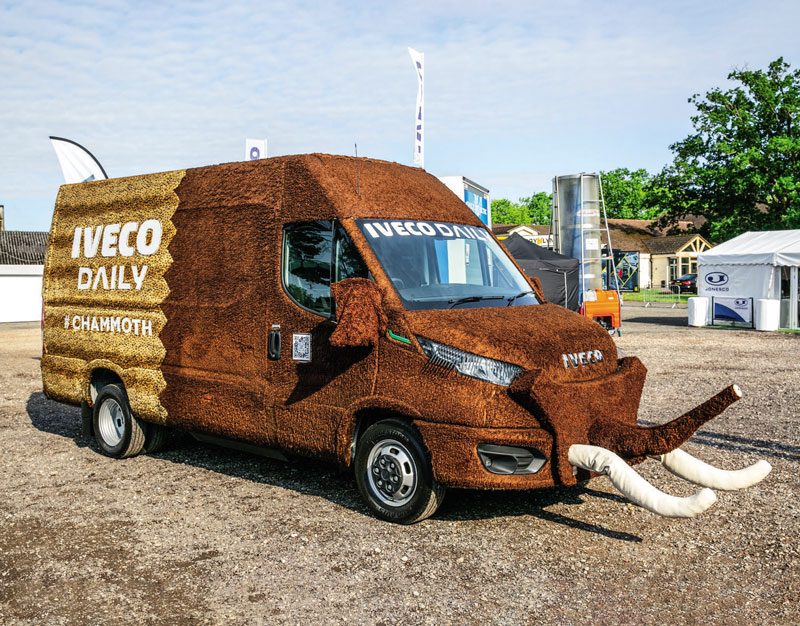Life left in diesel

Will Shiers searches for combustion- engine trucks on the manufacturers’ stands at the UK’s Road Transport Expo.
The UK has ambitious, and I would argue totally unrealistic, plans to decarbonise road transport. By 2030, we’ll be banning the sale of combustion-engine cars, followed five years later by all commercial vehicles up to 26 tonnes GVW, and everything above it by 2040.
Judging by the number of zero-tailpipe-emission trucks on show, ill-informed visitors at this year’s Road Transport Expo (RTX) trade show could have been tricked into thinking that we’re well on the way to reaching those targets, such was the vast array of battery-powered commercial vehicles on show. In reality, just a few hundred electric trucks have entered service in the UK. While visiting RTX, which took place in late June at Stoneleigh Park NAEC in the heart of England, I called in on all 10 of the truck manufacturers’ stands hoping to find proof that there’s still life left in diesel.
For several years, DAF Trucks has been promoting the benefits of hydrotreated vegetable oil (HVO) as a low-carbon alternative to diesel, and indeed has run its demo fleet on the fuel for a long time. HVO has the potential to reduce CO2 by up to 90%, and in my opinion (along with other synthetic fuels), will ultimately prolong the life of the combustion engine. In fact, the manufacturer had refreshingly few battery-powered trucks on its stand, instead devoting most of the space to its New Generation range. The most recent of these are the XD distribution and XDC construction trucks, which were jointly crowned International Truck of the Year (IToY) 2023. At the show, I was joined by five fellow jury members when I handed over the trophy to DAF Trucks UK marketing manager Phil Moon.
DAF assembles most of its UK-spec trucks in Leyland, Lancashire, and despite being a US-owned Dutch company, is widely considered by many to be the closest thing the country has to a British truck manufacturer. This helps to explain DAF’s 30%-plus market share and 28 years of UK market leadership.
Daimler Trucks chose RTX for the UK premiere of no less than three different vehicles. Taking pride of place on its outdoor stand was a Mercedes-Benz eEconic 300 refuse truck, while inside the halls, it debuted its New Generation FUSO eCanter. That said, my pick of three launches was the Mercedes-Benz Actros Edition 3. The manufacturer anticipates selling just 20 of these 630hp flagship tractors in the UK. It was located on the Kuda Automotive stand, the customising and accessory specialist having fitted the top-spec truck with side skirts, a full-size catwalk, TV, microwave and CabStore lockers on the rear cab wall.
There was no escaping battery-powered trucks at Electra, seeing as that’s all the company offers. Based in the northwest of England, it produces a range of battery electric trucks between 12 and 27 tonnes. It can build its electric driveline onto a variety of chassis but mostly uses Iveco Eurocargo and Mercedes-Benz Econic gliders.
It was diesel all the way at Isuzu Trucks, which won’t launch its first generation of electric vehicles until 2024. The manufacturer, which only operates in the 3.5- to 13.5-tonne GVW sector in the UK, has witnessed a significant increase in sales in recent years. MD Peter Murphy explained that the company wasn’t affected by the global microchip shortage to the same extent as some of its competitors, so it had comparatively short lead times. This attracted new customers, many of whom would not normally have considered Isuzu over traditional brands. “They have been suitably impressed, and we are seeing repeat orders on the back of that,” he said. Isuzu is number two in the UK’s important but diminishing 7.5-tonne sector and has set its sights on knocking DAF off the No.1 spot.
IVECO is undergoing a complete image transformation in the UK, all built on the back of its successful S-Way range. Having struggled to win drivers’ favour for decades, it suddenly has a truck that they want to be seen in. This, coupled with shorter lead times than some rivals, has seen it triple its sales in the past few years.
“Between 2017 and 2019, we were selling circa 1500 trucks at 7.5 tonnes and above per annum, whereas now we are looking at a broad run rate of 5000 trucks,” said Gareth Lumsdaine, business line director of truck. This makes the UK its fastest-growing market worldwide. IVECO is now looking to improve its performance in the eight-legger market, too, and has partnered with local bodybuilder Thompsons Group to produce ready-to-go X-Way tippers.
MAN Truck & Bus is yet to launch its electric offerings, and all eyes at the show were on the stunning TGX Individual Lion S tractor, which took centre stage on its stand. Belonging to Templeman Retailing & Vending, this head-turner is the 150,000th MAN to be sold in the UK. The heavily customised truck was the brainchild of company chairman Neil Templeman, who sadly passed away before the truck hit the roads.
In addition to showcasing its extensive range of E-Tech electric vehicles, Renault Trucks proved that there’s also life left in diesel. It has recently launched its Turbo Compound tractors and had a pair of them on show and another in the Ride & Drive zone. According to Renault’s data, the Turbo Compounds already with UK customers are proving to be 8.6% more fuel efficient than DTi 480 tractors.
Over the years, a couple of Chinese truck makers have tried and failed to make an impact in the UK. The latest entrant to the market is the Putzmeister eMixer. This battery-powered 8×4 concrete mixer features a SANY eTruck chassis, which is manufactured in China by Putzmeister’s parent company Sany Group.
Although this was the truck’s first UK showing, it has been in production in China since 2019. It has been reworked for the European market, and 25 examples have operated in various countries since the vehicle’s launch at last year’s Bauma construction trade show in Munich, Germany. The truck’s 350kW LFP batteries power a 250kW (360kW peak) electric motor and give the truck a range of up to 288km. The batteries are mounted directly behind the cab but can be moved to the chassis for other applications.
I confess to having walked past this Scania 6×2 tractor several times before twigging what it was. However, Scania enthusiasts were far more observant than me and were quick to realise that this wasn’t an ordinary 660S, having spotted the extended rear cab wall discreetly hiding behind the side fairings. Belonging to haulier Morgan Transport, it’s one of two CS 23s in the UK. The CR 23 and CS 23 cabs, launched earlier this year, have been extended by 270mm behind the B-pillar, increasing interior volume by 13%. They are built for Scania by its subsidiary Laxå Special Vehicles, which also produces crew cabs and was previously responsible for the legendary T-cab.
Last but by no means least, we have Volvo Trucks, which premiered an FH16 650 8×4 heavy haulage tractor. The 180-tonner, the latest eye-catcher on its demonstration fleet, is full factory spec, except for a Popp towing hook at the front. The Globetrotter XL-cabbed tractor, which features top-of-the-range Drive 16 ++ trim, was coupled to a Broshuis low-loader trailer. On the back, you’ll notice an FM 460 Lite 6×2 tractor, which is proving popular in the UK. It features a mini mid-lift axle, 490kg lighter than a conventional 6×2.
This impressive outfit was a reminder that while some sectors of the industry, like urban distribution, are arguably suited to electrification, we’re a long way from replacing diesel for heavy haulage.

Iveco Chammoth
I would love to have been a fly on the wall in the IVECO marketing meeting when they conceived the Chammoth. Half-cheetah and half-mammoth, it supposedly encompasses two key qualities of the Daily van; strength and agility. It is covered with fake fur, and I can confirm that it smells a bit like wet dog after a rain shower!
Read more
From our travels
0 Comments1 Minute
Maximum nostalgia
0 Comments5 Minutes
Meeting Volvo’s VNL
0 Comments13 Minutes
A yank with a Dutch touch
0 Comments8 Minutes
















